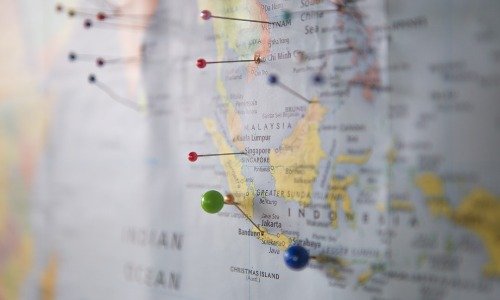Like many people, I was once chained to money and let it control me. I even refused to look at my student loan balance. I had no idea how to be financially free or even what that meant. I discovered financial independence thanks to my partner who was binging FI podcasts. I still wasn’t totally sold on the idea, and that’s because financial freedom seemed so far out of reach.
What did appeal to me was the idea of using money to bring more of what I loved into my life and less of what I didn’t. We set an initial goal of reaching financial independence in ten and a half years. We took tiny baby steps towards financial freedom and we have come a long way. That is why I want to share easy to follow money habits and steps so you can learn how to be financially free (and it doesn’t feel so far out of reach).
Why do you want to be financially free?
We learned pretty quickly that without a strong ‘why,’ your motivation to pursue financial freedom wanes. It’s not easy setting aside huge portions of your income to chase down your money goals. If you don’t have a strong vision of what you want your life to look like, you’re less likely to sacrifice and more likely to indulge.
Your ‘why’ might include:
- The luxury of being able to focus on your family over your career.
- The ability to travel.
- The ability to transition to a different career field that’s more meaningful to you.
- More time for non-monetized hobbies.
There are no right or wrong answers. You simply need to ask yourself, ‘Why do I want to be financially free?’ Try this sentence frame:
“I am tired of my money _________________________ and instead I want it to ______________________ for me and my life.”
What does financial freedom look like to you?

Now that you have your why, you can delve into the nuts and bolts of what your life will look like after you achieve financial freedom. To draw up your financial independence plan, you might want to ask yourself:
- Will I retire completely or switch to more meaningful work?
- What kind of schedule will I maintain on a day-to-day basis?
- What will my housing situation be? Will I live in a traditional home or something more mobile, like a boat or RV?
- If you don’t have children yet, do you plan on it in the future? How will you need to adjust your financially-free lifestyle to accommodate their needs?
It’s important to think these things through. In the end, your financial independence plan may not work out exactly the way you expect. Your feelings about child-rearing may change as you transition into parenthood. You may encounter health problems that necessarily affect the lifestyle you envisioned.
But by shooting for the most ideal lifestyle you can imagine, you can keep yourself motivated to save and invest and make your money work for you. That financial preparedness will serve as a cushion, providing you with more options and opportunities even if your ideal plan gets derailed.
How to Be Financially Free- The 8 Money Habits that Will Get You There

The path to financial freedom and independence is full of both numbers and feelings. Here’s how to become financially free in eight steps, taking both factors into account.
1. Determine your ‘why’ for financial independence.
Remember, without that ‘why,’ it’s going to be a lot harder to stick to your budget and reach your goals. Identifying it is a crucial step.
2. Learn how to be financially free with a budget as your tool.
The act of budgeting creates a plan for your money. It empowers you to tell your money what to do instead of wondering what happened to it.
The first step in budgeting is expense tracking. This is where you look back on your past few months of financial statements to see how you spent or saved your money. Then you can do this on a regular basis, even weekly. You can ask yourself, “is my money going towards things I love and my goals?”
3. Spend less than you earn.
Once you have an accurate picture of your habits, you can determine if they line up with your values. When you’re pursuing financial freedom, a huge part of the equation is spending less than you earn.
The reason is two-fold. First, spending less than you earn lowers your expenses every year. When you learn to get by on less, you won’t need as much money to reach financial independence.
The other reason to spend less than you earn is that you need to save a huge portion of your income in order to retire. This is especially true if you plan to retire in 10 years or less. If you don’t spend less than you earn, investing and saving a portion of your income is impossible.
Ideally, you can save 50% or more of your income if you plan to reach traditional financial independence- which is retiring completely. If you want to reach your own version of financial freedom this number will change.
4. Build savings.
The first step to becoming financially free is establishing basic economic security. That’s why you need to build an emergency fund before you do anything else. In normal times, an emergency fund might cover something like an unexpected medical bill or car repair. In our current era, emergency funds can often be used to cover basic expenses if you suddenly lose your job.
Traditionally, you’re supposed to set $1,000 as your initial goal for an emergency fund. That’s still a good initial goal. But many financial professionals are now recommending a 6-12 month, liquid emergency fund to cover things like the mortgage and food in case of an emergency.
It’s always a good idea to keep your emergency fund in a high-yield savings account so you are getting some kind of return. To simplify this process set up an automatic savings withdrawal from your paycheck straight into your emergency fund.
5. Pay off (some of) your debt.
Not all debt is created equal. Some debt — like the kind you can incur when using credit cards — is high-interest. It should be a priority to pay this off over any extraneous investing.
However, if you have an auto loan or mortgage with a low-interest rate, you may want to continue making your monthly payments as scheduled. You don’t necessarily need to pursue aggressive debt payoff if your investments earn more money than your debt costs.
The number we generally use in our calculations is somewhere around 7%. That’s our estimated average annual return from our investments. If we had financed a car at 3%, our money would be better spent on investments than paying off the car.
But if we had a credit card carrying a balance at 22% APR, that would definitely need to be paid off before we diverted any additional funds to our retirement accounts. Check out the post I wrote for Business Insider about paying off student loan debt while still investing to see another example with the math.
6. Invest in index funds.
The reason we use the 7% number as an estimated average annualized return is that we invest in index funds. Index funds allow you to invest in the broad spectrum of the American economy. It’s a fund that’s ‘indexed’ to the S&P 500. Because the S&P 500 has historically gone up over longer time horizons, index funds are expected to do the same.
At least that’s how it is with Vanguard’s most popular funds, which are our investment of choice. We decided on Vanguard’s index funds when we were initially deciding how to be financially free. We chose them because they come with some of the lowest expense ratios on the market, which leaves us with more money for early retirement. You situation may be different and I am not qualified to give investing advice. Please consult a credentialed expert with your questions on this.
7. Learn about taxes before pursuing financial freedom.
You cannot make an effective plan for financial freedom without understanding tax law. Now, that doesn’t mean you have to read the entirety of IRS tax code.(Yuck!) But you do need to understand the basics when it comes to taxes and investment accounts.
Certain tax-advantaged retirement accounts — like a 401(k) — allow you to contribute money into your account before taxes. This allows you to save more while also reducing your taxable income. However, you will be taxed when you take money out later in life.
Other tax-advantaged retirement accounts — like a Roth IRA — don’t allow you to do the same thing. Instead, you contribute money after you’ve already paid income taxes. But then, when you make qualified withdrawals later in life, you won’t have to pay taxes on any money you take out.
If you’re saving aggressively for financial independence, you may max out your available tax-advantaged accounts. When this happens, you’ll need to start studying up on taxable investments.
8. Track your net worth.
Your net worth is a snapshot of your current financial situation. You add together all of your cash and assets. Then you subtract all your debts. The final number is your net worth.
By tracking your net worth over time, you can watch your own progress and growth. You can use tech tools and calculators to project your net worth out into the future, too. That way you can ensure that your actions today are matching up with your plans for tomorrow. We use the Personal Capital app to track our net worth.
The Numbers Behind Achieving Financial Freedom
Let’s look at an example so you can see how the numbers might play out. Let’s say you want to know how to be financially free in 10 years or so. You would need to:
- Save 65% of your income for 10.5 years.
- Live on the remaining 35%.
- That 35% number is the same amount you’ll be living on every year for the rest of your life.
- You will not withdraw more than 4% of your total investments in any given year after you reach financial freedom.
- Your investments and withdrawals must be optimized for taxes.
If you wanted to achieve financial independence in a shorter time frame, you’d need to save a higher percentage. For example, if you’re wondering how to be financially free in five years, you’d need to do the math. Here’s the basic formula:
{(Your annual income) * [100-(Your savings rate)]*25}/(Your savings rate)*(Your annual income) = (Number of years to achieve financial freedom)
If you make $100,000/year and you wanted to achieve financial freedom in five years, your formula would look like this with the numbers plugged in:
{$100,000*[100-(Your savings rate)]*25}/(Your savings rate)*$100,000 = 5 years
You’d arrive at a savings rate of 83%. If you made $100,000/year, that would mean lowering your annual expenses to $17,000/year. Whether or not that’s possible depends on multiple factors like your willingness to cut expenses — even to the point of extreme frugality — your health insurance situation and cost of living in your area.
How to Be Financially Free is Easy, The ‘Why’ is Essential

The math is easy enough to figure out. Ultimately, the question isn’t ‘how’ to be financially free. The better question is, ’Why?’
It’s that ‘why’ that’s going to help you achieve your goals. It’s that ‘why’ that will help you change the things are in your control and unlock the door to greater possibilities. And it’s that ‘why’ that will help you actualize your goal of financial freedom.
You may not want to retire early and instead just get rid of debt, own your money and invest for a future retirement date- and that’s ok too. To be financially free- whatever that looks like for you- can still be reached using the 8 money habits above.
FAQ’s on how to be financially free
What is financial freedom?
Financial freedom is the point where your investments can pay for your lifestyle. It is a point where you do not need to work any longer.
How do I achieve financial freedom?
Achieving financial freedom takes a ton of dedication, hard work, and discipline. It takes a dedicated plan to achieve a certain financial figure to where your investments will pay for your lifestyle.
How much money do you need for financial freedom?
The answer is different for everyone. It is based on the cost of your lifestyle, where you live, how your investments are set up, and if your investments consistently pay you the returns you expect.



3 comments
I was reading too fast and at first I thought you said to read the IRS tax code. I was like, oh nooooooo! 🙂 Cheers to financial freedom!
Haha! Oh my gosh- that would be my nightmare.
Thank you for reading!
All good advice. 65% may be too much for most people to save though. That’s fairly high number.